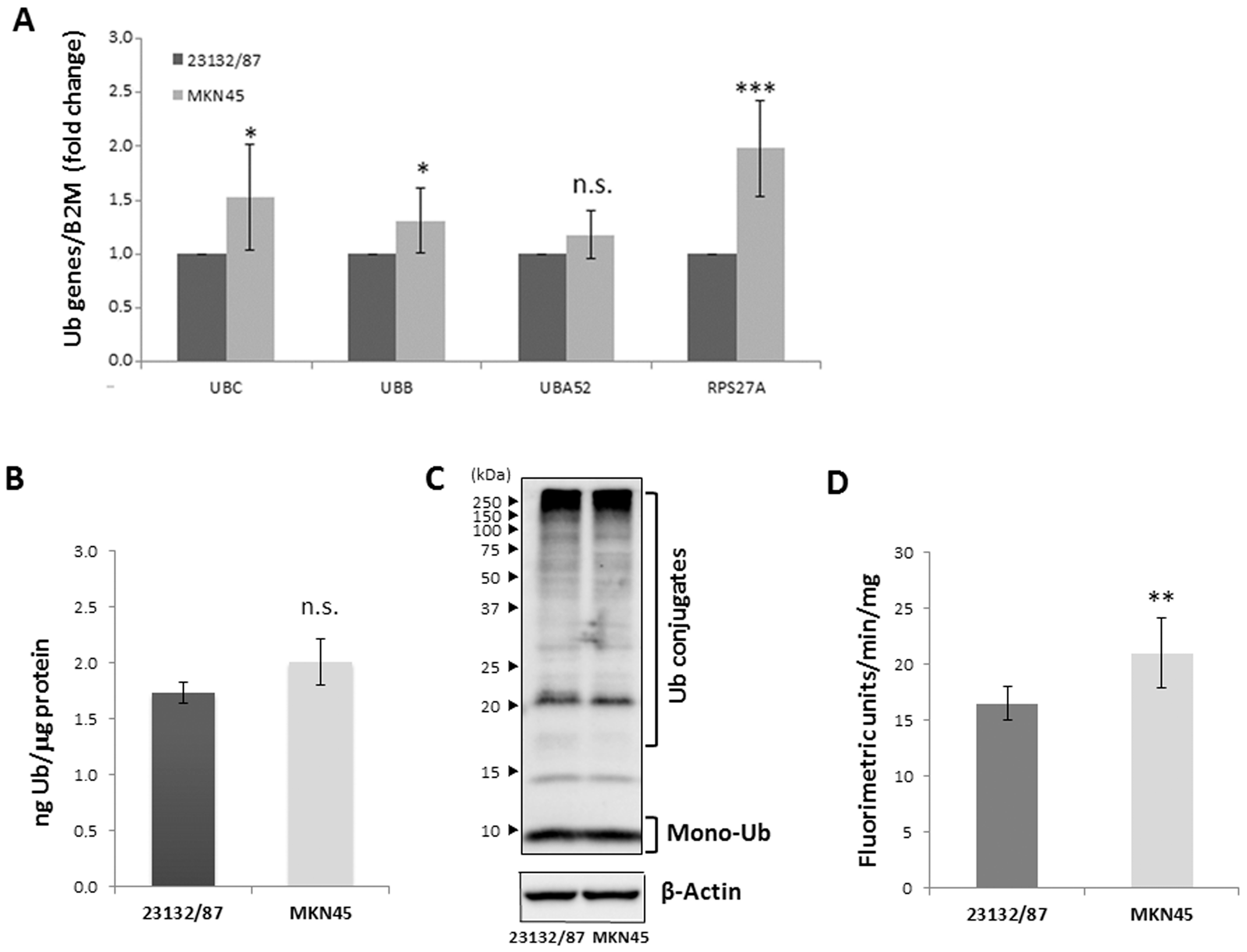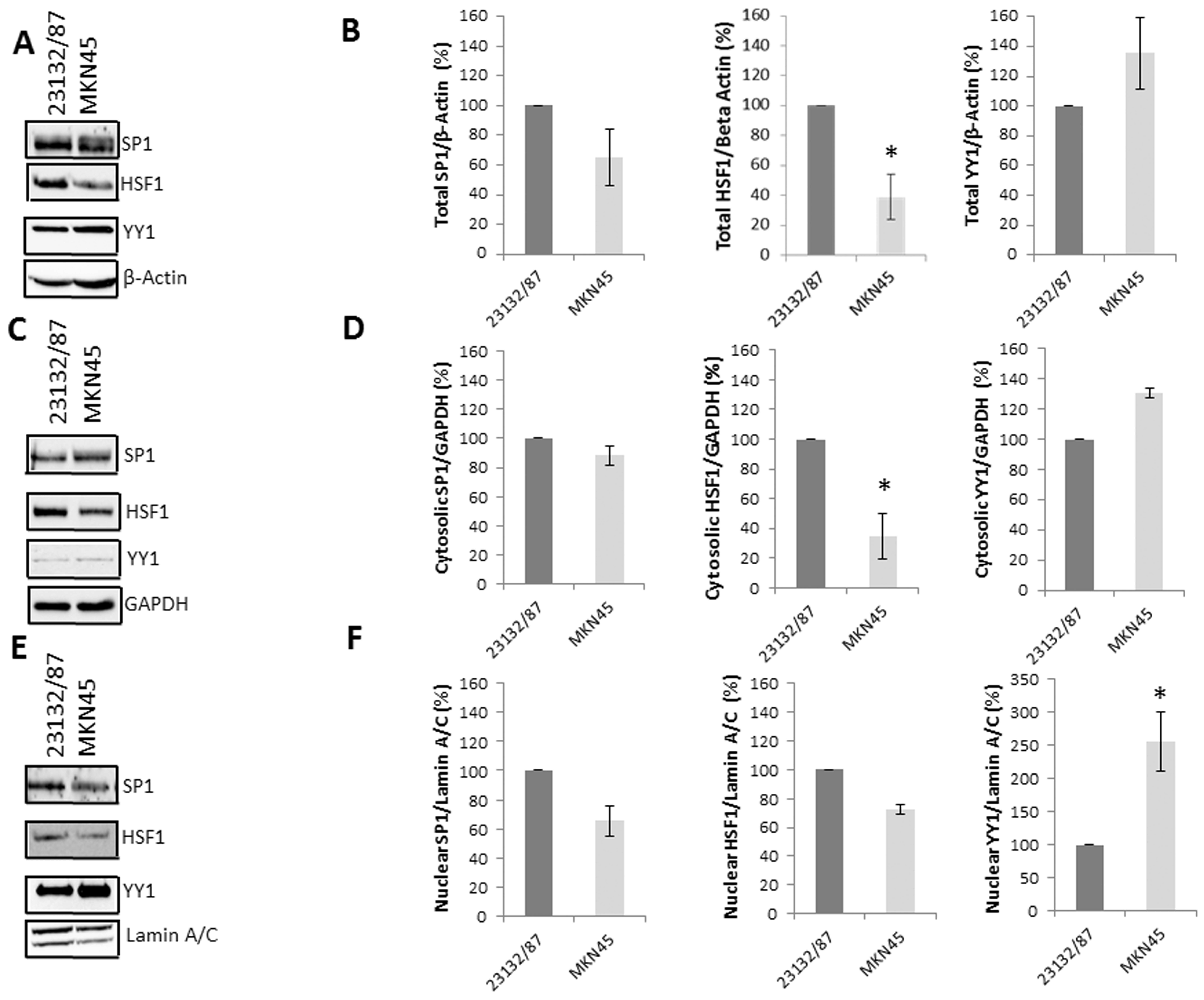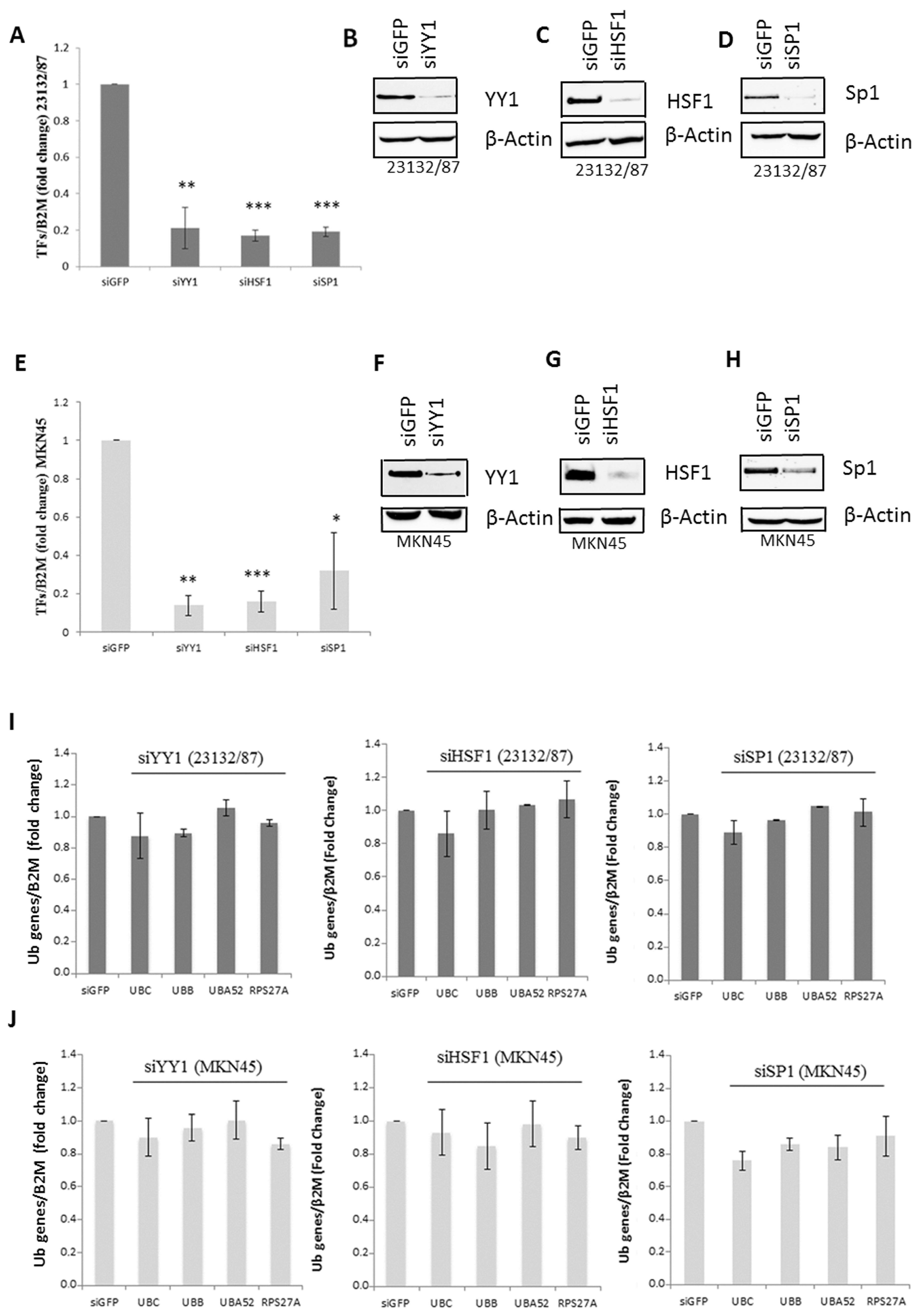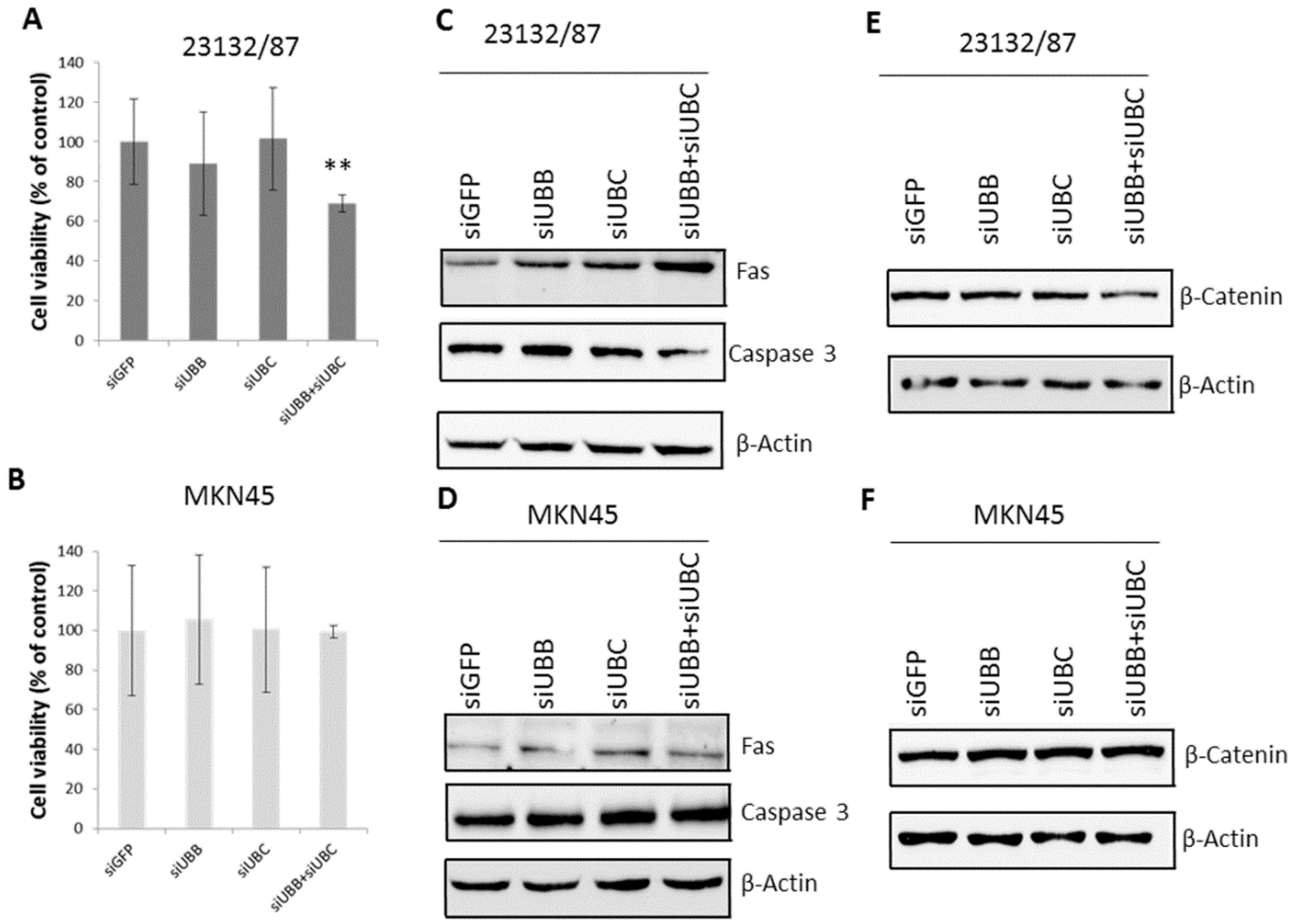The Ubiquitin Gene Expression Pattern and Sensitivity to UBB and UBC Knockdown Differentiate Primary 23132/87 and Metastatic MKN45 Gastric Cancer Cells
Abstract
1. Introduction
2. Results
2.1. Characterization of Ub Expression Profile in Primary 23132/87 and Metastatic MKN45 GC Cells
2.2. Cytosolic and Nuclear Distribution of YY1, HSF1 and SP1 in 23132/87 and MKN45 GC Cell Lines
2.3. Effect of YY1, HSF1 and SP1 Transcription Factor Silencing on Ub Gene Expression
2.4. Role of UBB and UBC in Gastric Adenocarcinoma Cell Proliferation and Survival
3. Discussion
4. Materials and Methods
4.1. Cell Cultures and Chemicals
4.2. Small Interfering RNA Transfection in 23132/87 and MKN45 Cells
- Hs_YY1: ATGCCTCTCCTTTGTATATTA
- Hs_HSF1: CAGGTTGTTCATAGTCAGAAT
- Hs_SP1: TTGGGTAAGTGTGTTGTTTAA
- Hs_UBB: CCAAGATCCAAGATAAAGA
- Hs_UBC: GATCAGCAGAGGTTGATCT
- GFP: CGGCAAGCTGACCCTGAAGTTCAT
4.3. Real-Time Quantitative Polymerase Chain Reaction (RT-qPCR)
4.4. Cell Extracts
4.5. Western Blot Analysis
4.6. Cell Viability Assay
4.7. Proteasome Activity Assay
4.8. Ubiquitin Carboxyl-Terminal Hydrolase 2 (Usp2) Digestion and Mono-Ubiquitin Quantification
4.9. Statistical Analysis
Supplementary Materials
Author Contributions
Funding
Acknowledgments
Conflicts of Interest
Abbreviations
| B2M | Beta-2-Microglobulin |
| BAX | Bcl-2-like protein 4 |
| C-MYC | Avian myelocitomatosis virus oncogene cellular homolog |
| CRIP1 | Cysteine-rich intestinal protein 1 |
| DTT | Dithiotreitol |
| DUB | Deubiquitinase |
| EDTA | Ethylenediaminetetraacetic acid |
| EMT | Epithelial to mesenchymal transition |
| FasL | Fas ligand |
| GAPDH | Glyceraldehyde 3-phosphate dehydrogenase |
| GC | Gastric cancer |
| GFP | Green fluorescent protein |
| HRP | Horseradish peroxidase |
| HSF1 | Heat shock factor 1 |
| KLF4 | Kruppel-like factor 4 |
| LUCAT1 | Lung cancer-associated transcript 1 |
| MDM2 | Mouse double minute 2 homolog |
| MTS | 3-(4,5-dimethylthia-zol-2yl)-5-(3-carboxymethoxyphenyl)-2-(4-sulfophenyl)2H-tetrazolium |
| NEM | N-ethylmaleimide |
| PARP1 | Poly(ADP-ribose) polymerase 1 |
| PBS | Phosphate buffered saline |
| RPS27A | Ribosomal protein s27a |
| RT-qPCR | Real-time quantitative polymerase chain reaction |
| SDS | Sodium dodecyl sulfate |
| SDS-PAGE | SDS polyacrylamide gel electrophoresis |
| siRNA | Small interfering RNA |
| SP1 | Specificity protein 1 |
| SYBR | Synergy Brands |
| TF | Transcription factor |
| Ub | Ubiquitin |
| UBB | Ubiquitin B |
| UBA52 | Ubiquitin a-52 residue ribosomal protein fusion product 1 |
| UBC | Ubiquitin C |
| Usp2 | Ubiquitin carboxyl-terminal hydrolase 2 |
| YY1 | Yin yang 1 |
References
- Hershko, A.; Ciechanover, A. The ubiquitin system. Annu. Rev. Biochem. 1998, 67, 425–479. [Google Scholar] [CrossRef] [PubMed]
- Komander, D.; Rape, M. The ubiquitin code. Annu. Rev. Biochem. 2012, 81, 203–229. [Google Scholar] [CrossRef] [PubMed]
- Park, C.W.; Ryu, K.Y. Cellular ubiquitin pool dynamics and homeostasis. BMB Rep. 2014, 47, 475–482. [Google Scholar] [CrossRef] [PubMed]
- Kaiser, S.E.; Riley, B.E.; Shaler, T.A.; Trevino, R.S.; Becker, C.H.; Schulman, H.; Kopito, R.R. Protein standard absolute quantification (PSAQ) method for the measurement of cellular ubiquitin pools. Nat. Methods 2011, 8, 691–696. [Google Scholar] [CrossRef]
- Wiborg, O.; Pedersen, M.S.; Wind, A.; Berglund, L.E.; Marcker, K.A.; Vuust, J. The human ubiquitin multigene family: Some genes contain multiple directly repeated ubiquitin coding sequences. EMBO J. 1985, 4, 755–759. [Google Scholar] [CrossRef]
- Finley, D.; Bartel, B.; Varshavsky, A. The tails of ubiquitin precursors are ribosomal proteins whose fusion to ubiquitin facilitates ribosome biogenesis. Nature 1989, 338, 394–401. [Google Scholar] [CrossRef]
- Baker, R.T.; Board, P.G. The human ubiquitin-52 amino acid fusion protein gene shares several structural features with mammalian ribosomal protein genes. Nucleic Acids Res. 1991, 19, 1035–1040. [Google Scholar] [CrossRef]
- Reyes-Turcu, F.E.; Ventii, K.H.; Wilkinson, K.D. Regulation and cellular roles of ubiquitin-specific deubiquitinating enzymes. Annu. Rev. Biochem. 2009, 78, 363–397. [Google Scholar] [CrossRef]
- Oh, C.; Park, S.; Lee, E.K.; Yoo, Y.J. Downregulation of ubiquitin level via knockdown of polyubiquitin gene Ubb as potential cancer therapeutic intervention. Sci. Rep. 2013, 3, 2623–2631. [Google Scholar] [CrossRef]
- Tang, Y.; Geng, Y.; Luo, J.; Shen, W.; Zhu, W.; Meng, C.; Li, M.; Zhou, X.; Zhang, S.; Cao, J.; et al. Downregulation of ubiquitin inhibits the proliferation and radioresistance of non-small cell lung cancer cells in vitro and in vivo. Sci. Rep. 2015, 5, 9476–9487. [Google Scholar] [CrossRef]
- Deshaies, R.J. Proteotoxic crisis, the ubiquitin-proteasome system, and cancer therapy. BMC Biol. 2014, 12, 94–107. [Google Scholar] [CrossRef] [PubMed]
- Wan, Q.; Dingerdissen, H.; Fan, Y.; Gulzar, N.; Pan, Y.; Wu, T.J.; Yan, C.; Zhang, H.; Mazumder, R. BioXpress: An integrated RNA-seq-derived gene expression database for pan-cancer analysis. Database (Oxford) 2015, 2015, bav019. [Google Scholar] [CrossRef] [PubMed]
- Cooper, A.R.; Lill, G.R.; Gschweng, E.H.; Kohn, D.B. Rescue of splicing-mediated intron loss maximizes expression in lentiviral vectors containing the human ubiquitin C promoter. Nucleic Acids Res. 2015, 43, 682–690. [Google Scholar] [CrossRef] [PubMed]
- Bianchi, M.; Crinelli, R.; Giacomini, E.; Carloni, E.; Magnani, M. A potent enhancer element in the 5′-UTR intron is crucial for transcriptional regulation of the human ubiquitin C gene. Gene 2009, 448, 88–101. [Google Scholar] [CrossRef]
- Bianchi, M.; Crinelli, R.; Giacomini, E.; Carloni, E.; Radici, L.; Magnani, M. Yin Yang 1 intronic binding sequences and splicing elicit intron-mediated enhancement of ubiquitin C gene expression. PLoS ONE 2013, 8, e65932. [Google Scholar] [CrossRef]
- Crinelli, R.; Bianchi, M.; Radici, L.; Carloni, E.; Giacomini, E.; Magnani, M. Molecular Dissection of the Human Ubiquitin C Promoter Reveals Heat Shock Element Architectures with Activating and Repressive Functions. PLoS ONE 2015, 10, e0136882. [Google Scholar] [CrossRef]
- Marinovic, A.C.; Zheng, B.; Mitch, W.E.; Price, S.R. Ubiquitin (UbC) expression in muscle cells is increased by glucocorticoids through a mechanism involving Sp1 and MEK1. J. Biol. Chem. 2002, 277, 16673–16681. [Google Scholar] [CrossRef]
- Mao, X.; Zhu, X.; Hurren, R.; Ezzat, S.; Schimmer, A.D. Dexamethasone increases ubiquitin transcription through an SP-1 dependent mechanism in multiple myeloma cells. Leukemia Res. 2008, 32, 1480–1482. [Google Scholar] [CrossRef]
- Vihervaara, A.; Sergelius, C.; Vasara, J.; Blom, M.A.; Elsing, A.N.; Roos-Mattjus, P.; Sistonen, L. Transcriptional response to stress in the dynamic chromatin environment of cycling and mitotic cells. Proc. Natl. Acad. Sci. USA 2013, 110, E3388–E3397. [Google Scholar] [CrossRef]
- Bianchi, M.; Giacomini, E.; Crinelli, R.; Radici, L.; Carloni, E.; Magnani, M. Dynamic transcription of ubiquitin genes under basal and stressful conditions and new insights into the multiple UBC transcript variants. Gene 2015, 573, 100–109. [Google Scholar] [CrossRef]
- Bianchi, M.; Crinelli, R.; Arbore, V.; Magnani, M. Induction of ubiquitin C (UBC) gene transcription is mediated by HSF1: Role of proteotoxic and oxidative stress. FEBS Open Bio 2018, 8, 1471–1485. [Google Scholar] [CrossRef] [PubMed]
- Kang, W.; Tong, J.H.; Chan, A.W.; Zhao, J.; Dong, Y.; Wang, S.; Yang, W.; Sin, F.M.; Ng, S.S.; Yu, J.; et al. Yin Yang 1 contributes to gastric carcinogenesis and its nuclear expression correlates with shorter survival in patients with early stage gastric adenocarcinoma. J. Transl. Med. 2014, 12, 80–90. [Google Scholar] [CrossRef] [PubMed]
- Yao, J.C.; Wang, L.; Wei, D.; Gong, W.; Hassan, M.; Wu, T.T.; Mansfield, P.; Ajani, J.; Xie, K. Association between expression of transcription factor Sp1 and increased vascular endothelial growth factor expression, advanced stage, and poor survival in patients with resected gastric cancer. Clin. Cancer Res. 2004, 10, 4109–4117. [Google Scholar] [CrossRef] [PubMed]
- Kim, S.J.; Lee, S.C.; Kang, H.G.; Gim, J.; Lee, K.H.; Lee, S.H.; Chun, K.H. Heat Shock Factor 1 Predicts Poor Prognosis of Gastric Cancer. Yonsei Med. J. 2018, 59, 1041–1048. [Google Scholar] [CrossRef]
- Torre, L.A.; Bray, F.; Siegel, R.L.; Ferlay, J.; Lortet-Tieulent, J.; Jemal, A. Global cancer statistics, 2012. CA Cancer J. Clin. 2015, 65, 87–108. [Google Scholar] [CrossRef]
- Hu, B.; El Hajj, N.; Sittler, S.; Lammert, N.; Barnes, R.; Meloni-Ehrig, A. Gastric cancer: Classification, histology and application of molecular pathology. J. Gastrointest. Oncol. 2012, 3, 251–261. [Google Scholar]
- Grabsch, H.I.; Tan, P. Gastric cancer pathology and underlying molecular mechanisms. Digest. Surg. 2013, 30, 150–158. [Google Scholar] [CrossRef]
- Hanahan, D.; Weinberg, R.A. Hallmarks of cancer: The next generation. Cell 2011, 144, 646–674. [Google Scholar] [CrossRef]
- Tian, X.; Ju, H.; Yang, W. An ego network analysis approach identified important biomarkers with an association to progression and metastasis of gastric cancer. J. Cell. Biochem. 2019, 120, 15963–15970. [Google Scholar] [CrossRef]
- Kolligs, F.T.; Bommer, G.; Goke, B. Wnt/Beta-Catenin/Tcf Signaling: A Critical Pathway in Gastrointestinal Tumorigenesis. Digestion 2002, 66, 131–144. [Google Scholar] [CrossRef]
- van der Woude, C.J.; Kleibeuker, J.H.; Tiebosch, A.T.; Homan, M.; Beuving, A.; Jansen, P.L.; Moshage, H. Diffuse and intestinal type gastric carcinomas differ in their expression of apoptosis related proteins. J. Clin. Pathol. 2003, 56, 699–702. [Google Scholar] [CrossRef] [PubMed]
- Fornace, A.J., Jr.; Alamo, I., Jr.; Hollander, M.C.; Lamoreaux, E. Ubiquitin mRNA is a major stress-induced transcript in mammalian cells. Nucleic Acids Res. 1989, 17, 1215–1230. [Google Scholar] [CrossRef] [PubMed]
- Ryu, K.Y.; Baker, R.T.; Kopito, R.R. Ubiquitin-specific protease 2 as a tool for quantification of total ubiquitin levels in biological specimens. Anal. Biochem. 2006, 353, 153–155. [Google Scholar] [CrossRef] [PubMed]
- Davis, M.I.; Pragani, R.; Fox, J.T.; Shen, M.; Parmar, K.; Gaudiano, E.F.; Liu, L.; Tanega, C.; McGee, L.; Hall, M.D.; et al. Small Molecule Inhibition of the Ubiquitin-specific Protease USP2 Accelerates cyclin D1 Degradation and Leads to Cell Cycle Arrest in Colorectal Cancer and Mantle Cell Lymphoma Models. J. Biol. Chem. 2016, 291, 24628–24640. [Google Scholar] [CrossRef]
- Zhang, N.Y.; Jacobson, A.D.; Macfadden, A.; Liu, C.W. Ubiquitin chain trimming recycles the substrate binding sites of the 26 S proteasome and promotes degradation of lysine 48-linked polyubiquitin conjugates. J. Biol. Chem. 2011, 286, 25540–25546. [Google Scholar] [CrossRef]
- Shabek, N.; Herman-Bachinsky, Y.; Ciechanover, A. Ubiquitin degradation with its substrate, or as a monomer in a ubiquitination-independent mode, provides clues to proteasome regulation. Proc. Natl. Acad. Sci. USA 2009, 106, 11907–11912. [Google Scholar] [CrossRef]
- Sarvagalla, S.; Kolapalli, S.P.; Vallabhapurapu, S. The Two Sides of YY1 in Cancer: A Friend and a Foe. Front. Oncol. 2019, 9, 1230–1249. [Google Scholar] [CrossRef]
- Galloway, N.R.; Ball, K.F.; Stiff, T.; Wall, N.R. Yin Yang 1 (YY1): Regulation of Survivin and Its Role In Invasion and Metastasis. Crit. Rev. Oncog. 2017, 22, 23–36. [Google Scholar] [CrossRef]
- Hsu, T.S.; Mo, S.T.; Hsu, P.N.; Lai, M.Z. c-FLIP is a target of the E3 ligase deltex1 in gastric cancer. Cell Death Dis. 2018, 9, 135–146. [Google Scholar] [CrossRef]
- Zhang, N.; Zhang, J.; Shuai, L.; Zha, L.; He, M.; Huang, Z.; Wang, Z. Kruppel-like factor 4 negatively regulates β-catenin expression and inhibits the proliferation, invasion and metastasis of gastric cancer. Int. J. Oncol. 2012, 40, 2038–2048. [Google Scholar]
- Zhou, Q.; Hou, Z.; Zuo, S.; Zhou, X.; Feng, Y.; Sun, Y.; Yuan, X. LUCAT1 promotes colorectal cancer tumorigenesis by targeting the ribosomal protein L40-MDM2-p53 pathway through binding with UBA52. Cancer Sci. 2019, 110, 1194–1207. [Google Scholar] [CrossRef] [PubMed]
- Chi, J.; Liu, T.; Shi, C.; Luo, H.; Wu, Z.; Xiong, B.; Liu, S.; Zeng, Y. Long non-coding RNA LUCAT1 promotes proliferation and invasion in gastric cancer by regulating miR-134-5p/YWHAZ axis. Biomed. Pharmacother. 2019, 118, 109201. [Google Scholar] [CrossRef] [PubMed]
- Liu, Y.; Beyer, A.; Aebersold, R. On the Dependency of Cellular Protein Levels on mRNA Abundance. Cell 2016, 165, 535–550. [Google Scholar] [CrossRef]
- Schwanhausser, B.; Busse, D.; Li, N.; Dittmar, G.; Schuchhardt, J.; Wolf, J.; Chen, W.; Selbach, M. Global quantification of mammalian gene expression control. Nature 2011, 473, 337–342. [Google Scholar] [CrossRef] [PubMed]
- Shabek, N.; Ciechanover, A. Degradation of ubiquitin: The fate of the cellular reaper. Cell Cycle 2010, 9, 523–530. [Google Scholar] [CrossRef]
- Arora, N.; Alsaied, O.; Dauer, P.; Majumder, K.; Modi, S.; Giri, B.; Dudeja, V.; Banerjee, S.; Von Hoff, D.; Saluja, A. Downregulation of Sp1 by Minnelide leads to decrease in HSP70 and decrease in tumor burden of gastric cancer. PLoS ONE 2017, 12, e0171827. [Google Scholar] [CrossRef]
- Gencer, S.; Irmak Yazicioglu, M.B. Differential response of gastric carcinoma MKN-45 and 23132/87 cells to H2O2 exposure. Turk. J. Gastroenterol. 2011, 22, 145–151. [Google Scholar] [CrossRef]
- Kedves, A.T.; Gleim, S.; Liang, X.; Bonal, D.M.; Sigoillot, F.; Harbinski, F.; Sanghavi, S.; Benader, C.; George, E.; Gokhale, P.C.; et al. Recurrent ubiquitin B silencing in gynecological cancers establishes dependence on ubiquitin C. J. Clin. Investig. 2017, 127, 4554–4568. [Google Scholar] [CrossRef]
- Dantuma, N.P.; Groothuis, T.A.M.; Salomons, F.A.; Neefjes, J. A dynamic ubiquitin equilibrium couples proteasomal activity to chromatin remodeling. J. Cell Biol. 2006, 173, 19–26. [Google Scholar] [CrossRef]
- Holdenrieder, S.; Stieber, P. Apoptotic markers in cancer. Clin. Biochem. 2004, 37, 605–617. [Google Scholar] [CrossRef]
- Di Girolamo, M.; Fabrizio, G.; Scarpa, E.S.; Di Paola, S. NAD⁺-dependent enzymes at the endoplasmic reticulum. Curr. Top. Med. Chem. 2013, 13, 3001–3010. [Google Scholar] [CrossRef] [PubMed]
- Zhang, L.; Zhou, R.; Zhang, W.; Yao, X.; Li, W.; Xu, L.; Sun, X.; Zhao, L. Cysteine-rich intestinal protein 1 suppresses apoptosis and chemosensitivity to 5-fluorouracil in colorectal cancer through ubiquitin-mediated Fas degradation. J. Exp. Clin. Canc. Res. 2019, 38, 120–133. [Google Scholar] [CrossRef] [PubMed]
- Crinelli, R.; Bianchi, M.; Menotta, M.; Carloni, E.; Giacomini, E.; Pennati, M.; Magnani, M. Ubiquitin over-expression promotes E6AP autodegradation and reactivation of the p53/MDM2 pathway in HeLa cells. Mol. Cell. Biochem. 2008, 318, 129–145. [Google Scholar] [CrossRef]
- Hanna, J.; Meides, A.; Zhang, D.P.; Finley, D. A ubiquitin stress response induces altered proteasome composition. Cell 2007, 129, 747–759. [Google Scholar] [CrossRef] [PubMed]
- Peng, R.; Zhu, J.; Deng, S.; Shi, H.; Xu, S.; Wu, H.; Zou, F. Targeting BAX ubiquitin-binding sites reveals that BAX activation is essential for its ubiquitin-dependent degradation. J. Cell Biochem. 2020, 121, 2802–2810. [Google Scholar] [CrossRef]
- Zhou, S.; Lu, J.; Li, Y.; Chen, C.; Cai, Y.; Tan, G.; Peng, Z.; Zhang, Z.; Dong, Z.; Kang, T.; et al. MNAT1 is overexpressed in colorectal cancer and mediated p53 ubiquitin-degradation to promote colorectal cancer malignance. J. Exp. Clin. Cancer Res. 2018, 37, 284–300. [Google Scholar] [CrossRef]
- Geyer, P.E.; Maak, M.; Nitsche, U.; Perl, M.; Novotny, A.; Slotta-Huspenina, J.; Dransart, E.; Holtorf, A.; Johannes, L.; Janssen, K.P. Gastric Adenocarcinomas Express the Glycosphingolipid Gb3/CD77: Targeting of gastric Cancer Cells with Shiga Toxin B-Subunit. Mol. Cancer Ther. 2016, 15, 1008–1017. [Google Scholar] [CrossRef]
- Rocha, S.; Teles, S.P.; Azevedo, M.; Oliveira, P.; Carvalho, J.; Oliveira, C. Gastric Cancer Extracellular Vesicles Tune the Migration and Invasion of Epithelial and Mesenchymal Cells in a Histotype-Dependent Manner. Int. J. Mol. Sci. 2019, 20, 2608. [Google Scholar] [CrossRef]
- CanSAR Black—Cancer Drug Discovery Platform. Available online: https://cansarblack.icr.ac.uk/cell-line/MKN-45/copy-number (accessed on 21 May 2020).
- Livak, K.J.; Schmittgen, T.D. Analysis of relative gene expression data using real-time quantitative PCR and the 2(-Delta Delta C(T)) Method. Methods 2001, 25, 402–408. [Google Scholar] [CrossRef]





| Forward Primer | Sequence (5′ to 3′) | Reverse Primer | Sequence (5′ to 3′) |
|---|---|---|---|
| UBC-f | GTGTCTAAGTTTCCCCTTTTAAGG | UBC-r | TTGGGAATGCAACAACTTTATTG |
| UBB-f | CTTTGTTGGGTGAGCTTGTTTGT | UBB-r | GACCTGTTAGCGGATACCAGGAT |
| UBA52-f | CTGCGAGGTGGCATTATTGAG | UBA52-r | GTTGACAGCACGAGGGTGAAG |
| RPS27A-f | TCGTGGTGGTGCTAAGAAAAGG | RPS27A-r | TTCAGGACAGCCAGCTTAACCT |
| B2M-f | GCCTGCCGTGTGAACCAT | B2M-r | CATCTTCAAACCTCCATGATGCT |
| HSF1-f | CTGACGGACGTGCAGCTGAT | HSF1-r | CCCGCCACAGAGCCTCAT |
| YY1-f | GAAGCCCTTTCAGTGCACGTT | YY1-r | ACATAGGGCCTGTCTCCGGTAT |
| SP1-f | GCCTCTCAACTGCCCTAAGTCCT | SP1-r | ACCTGCCCTTGTCCACAATGTT |
| C-MYC-f | CTGAAGAGGACTTGTTGCGGAAAC | C-MYC-r | TCTCAAGACTCAGCCAAGGTTGTG |
© 2020 by the authors. Licensee MDPI, Basel, Switzerland. This article is an open access article distributed under the terms and conditions of the Creative Commons Attribution (CC BY) license (http://creativecommons.org/licenses/by/4.0/).
Share and Cite
Scarpa, E.S.; Tasini, F.; Crinelli, R.; Ceccarini, C.; Magnani, M.; Bianchi, M. The Ubiquitin Gene Expression Pattern and Sensitivity to UBB and UBC Knockdown Differentiate Primary 23132/87 and Metastatic MKN45 Gastric Cancer Cells. Int. J. Mol. Sci. 2020, 21, 5435. https://doi.org/10.3390/ijms21155435
Scarpa ES, Tasini F, Crinelli R, Ceccarini C, Magnani M, Bianchi M. The Ubiquitin Gene Expression Pattern and Sensitivity to UBB and UBC Knockdown Differentiate Primary 23132/87 and Metastatic MKN45 Gastric Cancer Cells. International Journal of Molecular Sciences. 2020; 21(15):5435. https://doi.org/10.3390/ijms21155435
Chicago/Turabian StyleScarpa, Emanuele Salvatore, Filippo Tasini, Rita Crinelli, Chiara Ceccarini, Mauro Magnani, and Marzia Bianchi. 2020. "The Ubiquitin Gene Expression Pattern and Sensitivity to UBB and UBC Knockdown Differentiate Primary 23132/87 and Metastatic MKN45 Gastric Cancer Cells" International Journal of Molecular Sciences 21, no. 15: 5435. https://doi.org/10.3390/ijms21155435
APA StyleScarpa, E. S., Tasini, F., Crinelli, R., Ceccarini, C., Magnani, M., & Bianchi, M. (2020). The Ubiquitin Gene Expression Pattern and Sensitivity to UBB and UBC Knockdown Differentiate Primary 23132/87 and Metastatic MKN45 Gastric Cancer Cells. International Journal of Molecular Sciences, 21(15), 5435. https://doi.org/10.3390/ijms21155435






